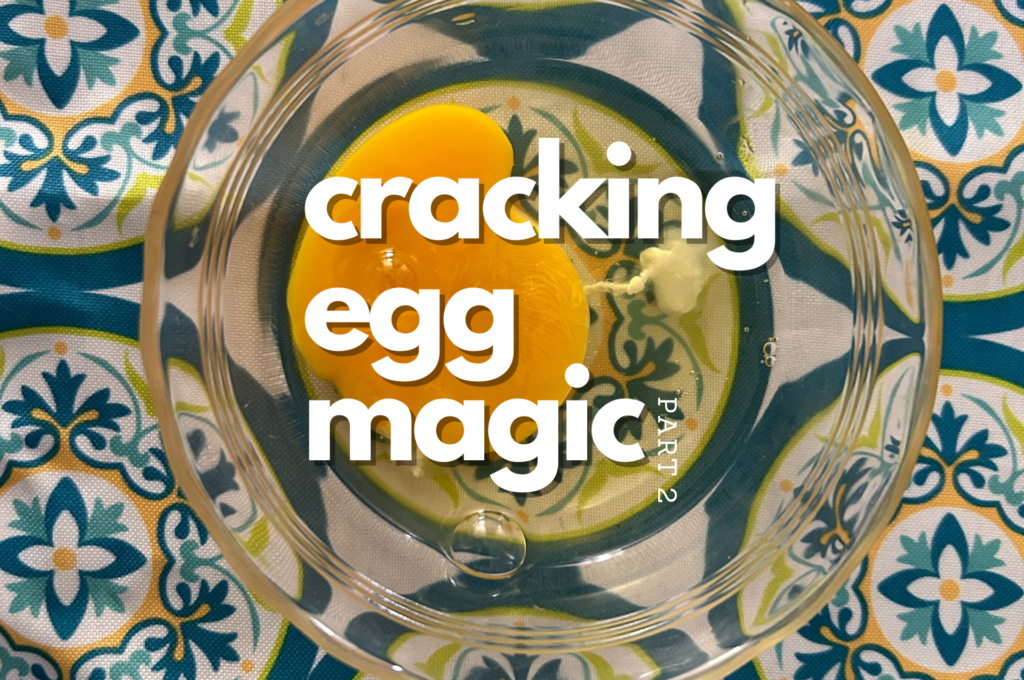
A basket of steaming chips sat in the middle of our table. My family and I hungrily reached for the fresh crispy chips, leading the warm, salted triangles into our mouths, and down into our grumbling bellies.
Meeting over margaritas and Mexican food is a sacred practice for my family. Nearly all of our family reunions happen at a handful of Mexican restaurants in our hometown. It seemed only fitting for me to start asking my mom about any folk practices she could recall from her childhood at this family dinner. And while there were a few, keeping on the themes of eggs, here is one she shared.
My mom called this one ojo curado, the “eye cure.”
Ojo Curado
Mom said that when there was a new infant, the infant would often be passed around the room, meeting all of the primos, and all of the various people who were in the life of the family, bringing a lot of eyes or attention to the child. If the child was able to settle and didn’t seem bothered by the attention, then this ceremony wasn’t necessary. However, if the child became cranky, fussy, or couldn’t settle down, it meant that too many eyes had been upon the babe, and that the evil eye was approaching. So when the baby was settled in their cradle, the parents would set a glass bowl with a cracked egg in it beneath the baby’s mattress. Like with the huevo limpia, the idea is that the egg would draw out the eyes that had been upon the child, capturing any excess or negativity that might have been cast, whether intentionally or not, upon the babe.
The next morning, the parents would check the egg; if there was a red dot, it meant that the eyes had been drawn out and that all would be well.
I realized as I was writing the draft of this post, that my mom didn’t say what would happen if the egg didn’t have the red dot. I suppose, based on what I’ve read so far, that the practice would be done again or that more steps, like adding the evil eye anklet to the child or somewhere within the room would be implemented. I also realized midway through writing this that I hadn’t asked her about if water was also in the bowl with the egg…
One text to my mom later and my mom really wasn’t sure of any more details, but then she text her Tia who said, “This was done when someone would make a big fuss over a baby, how cute and precious, and kiss the baby and they used to say (qui le Dacian ojo al Bebe that ( le calendavan la sangre al Bebe)”
My great tia went on to say, “…the baby was covered from head to toes with a white sheet, my Mom would get the egg and made the sign of the cross all over the baby holding the egg and she would pray three creeds., than she would brake the egg and placed it in the bowl. Amazing huh.”
Yes! It’s so amazing!
When I saw my mom after that conversation, she further recalled her grandmother saying the chant, “Qui le Dacian mojo al Bebe, le calendavan la sangre al bebe,” in a sing-song voice.
Why does this matter?
My great grandma passed away a few years ago and it was very hard on the family as she was the corazon, the heart. My mother loved her grandmother and it was so beautiful seeing the light of love and reflection in her eyes as she shared this story of the sweet practices her grandmother used to do. So aside from this sounding like it was a solid method regularly used for helping to calm down babies from being overstimulated with too much admiration, it helped to reconnect my mother to someone she dearly loved.
If you note, this tradition in particular is a blend of both native tactics with Catholic prayers. This is why early on, I started to wonder about what it means to be a bruja and how much these folk practices intertwine magical and spiritual forces with our daily lives, themes we’ll continue to explore!
Did/does your family practice this? If so, what’s the story your family tells? What would your family do if the red dot didn’t show up in the egg? Tell me all about it in the comments below!
Thank you for reading and we’ll see you in the next episode!

